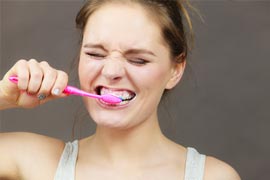November 2017
 Brushing your teeth isn't as easy as it seems. There are plenty of things to keep in mind when it comes to your dental hygiene. However, some of them are not as obvious as the ones you learned as a child.
Brushing your teeth isn't as easy as it seems. There are plenty of things to keep in mind when it comes to your dental hygiene. However, some of them are not as obvious as the ones you learned as a child.
Maintain a brushing time of two minutes
The most common thing we hear is to maintain a brushing time of two minutes. This can be tricky, and it's easy to lose track of time when waking up in the morning.
Some old tricks are:
Replace your toothbrush regularly
You should replace your toothbrush every three-months. By doing this you are preventing the build-up of bacteria on your brush. This will also stop frayed and worn out bristles from being ineffective. If you replace your brush every three months you will get a better, deeper clean than if you recycle an old brush. Some new brushes even come with replaceable heads to make it easier.
Do not rinse after brushing
Another common mistake is to rinse your mouth with water after you brush. When you rinse your mouth, you are removing the small amount of toothpaste that should be left behind to coat the teeth to help rebuild enamel and protect from cavities. If you do feel a need to rinse after brushing, make sure you use a mouthwash with fluoride. You can rinse, gargle and spit out the mouthwash, but don't use water.
Angles and pressure matter
The best way to approach your brushing technique is at a 45-degree angle with medium pressure. Too hard and you can erode the enamel, if you brush to softly you won't be able to penetrate the bacteria at the gum line. Always make sure to brush in a circular motion as well. When you do this, you can clean above and below the gum line. If you brush side-to-side then you may be causing damage to your gums and are not getting above and below the teeth.
Don't stick to a pattern
There are lots of things to keep in mind while going about your nightly or morning brushing routine. One way to help remember them all is to change the way you brush entirely. Don't stick to a pattern or you may start to get complacent and miss spots.
Follow the tips above and you will have a bright, white smile in no time!
Remember: The State of Texas Dental Discount Plan is not dental insurance. This discount plan allows you to pay a discounted fee at the time of service when you visit a participating network dentist. The State of Texas Dental Discount Plan can be used for routine and preventive care, specialty treatment and cosmetic services such as braces for children and adults, as well as teeth whitening. There are no limits on plan use, and savings start as soon as your plan takes effect.